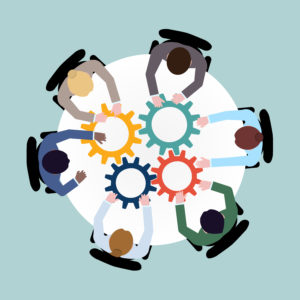
Workforce Analytics: How Big Data Is Shaping the Labor Pool

(Macrovector/Shutterstock)
How well do your employees perform? If you’re in the widget-making business, that’s a relatively easy question to answer. But in today’s highly diversified and increasingly digital economy, assessing the performance of your current or prospective labor pool increasingly requires the assistance of big data collection and analytics.
Since the dawn of free market capitalism, employers have struggled to find and retain the best employees. In a given population, only a fraction of the workers will be considered top-notch performers. Among employers, competition is fierce to find and retain those at the top of the bell curve, so it’s no wonder that the best-run companies are turning to big data to get an edge.
The folks at human resource (HR) software developer Ultimate Software have done some interesting work with big data analytics. The software-as-a-service (SaaS) provider has essentially baked big data analytics into its offerings, with the idea that HR managers who are armed with insight into employee performance will be better equipped to hire and retain top talent.
At the 2015 SAS Analytics Conference, Ultimate Software Associate Data Scientist Thomas Daglis provided some insight into the development of three labor indicators born of big data analytics, including the UltiPro Retention Predictor, the UltiPro High Performer Indicator, and the UltiPro High Performer Predictor.
With more than 3,200 customers across nearly every industry and country, Ultimate has a large pool of HR-related data to pull from. That also makes setting on performance proxies to feed its predictive models a bit challenging. While Daglis didn’t disclose the exact formula that the Florida software company uses for its predictions, he did say that some the best predictors of performance revolve around salary and career path.
“We really focus on how well they’re being rewarded by comparison to the rest of the company, and how quickly are they being promoted,” Daglis said. “The idea is that if you’re rewarding your top-tier individuals…consistently over a period of time, you probably value them, and if you value them they’re probably high performers.”
The algorithm that seeks to predict future high performance includes other factors, including their full job history, benefit and compensation history, education level, and licenses and accreditations. “Who controls the various scores? You do,” he told the audience. “Your actions can change your scores. The managers’ actions taken on you changes your score… I sleep better when I invest in people who are more likely to stay.”

Salary–along with job history and certifications–are strong predictors of future performance, according to Ultimate Software (Illustration: Elegant Solution/Shutterstock)
Managers need the help of analytics because they’re poor assessors of identifying talent, argued Daglis. “The manager cannot necessarily be trusted,” he said, citing research that shows humans can keep five to nine items in working memory at a given time. “If there are more than nine attributes you can use to make a determination of who the higher performers are, managers are going to fail at it.”
Another company at the cutting-edge of using big data to hire workers is AppDynamics, the San Francisco-based provider of IT management solutions. Competition for technical talent is ferocious in The City, so AppDynamics has upped its game with a multi-pronged approach to identifying, recruiting, and retaining people with the right skill-set.
“We live breath, walk and talk big data in recruiting candidates and retaining employees here at AppDynamics,” said Luan Lam, head of talent acquisition at the pre-IPO company, which has more than 1,000 employees and is currently hiring about 150 new employees per quarter.
LinkedIn (NYSE: LNKD) plays a big role in the company’s “candidate intelligence” process,. By crunching data collected from the professional social networking site, AppDynamnics can identify where the talent population resides and assessing whether the talent is ready to accept a job offer or whether they’re in exploration mode.
A third-party tool that has API hooks into all LinkedIn users’ profile pages gives AppDynamics insight into the state mind of a huge number of potential candidates. The tool tracks and measures how often a person is on their LinkedIn page, how often they’re updating it, whether they’re looking at different jobs, and whether they’re soliciting recommendations from other LinkedIn users.
“They may not be active on the job market, but he or she is thinking about a potential change or move. It tracks all of that and gives a percentage,” Lam said. “Ninety percent of the time, when we have reached out as a team to candidates who [the tool indicates] has a 75% chance of making a move, they have responded positively about having a conversation with us,” Lam said.
(Rawpixel/Shutterstock)
Having the right cultural fit is another important aspect of succeeding in a fast-based technical firm in San Francisco, and AppDynamics uses other data sources to assess whether the DNA of prospective employees is a good match.
To that end, AppDynamics tries to determine if the personality of a candidate will mesh with the team, in regards to “the way they think, their analytical skills,” Lam said. “We measure that against our top reps to make sure we are landing a consistent profile of top rep that we know is going to be successful.”
While managers may have relied on gut instincts in previous eras, that approach will become increasingly costly in today’s big data age. Luckily, the state of HR analytics is improving ,and hiring managers today have a growing selection of data-driven tools available to help them make better hiring decisions.
“Where the rubber meets the road,” Ultimate Software’s Daglis said, “is the concept that finally HR can step up to table and say, ‘I can get us a return on investment.'”
Related Items:
Unlocking Business Insights in Timecards
Can Workforce Analytics Help Us Find Work-Life Balance?
Are Meetings a Waste of Time? Data Analytics Weighs I































